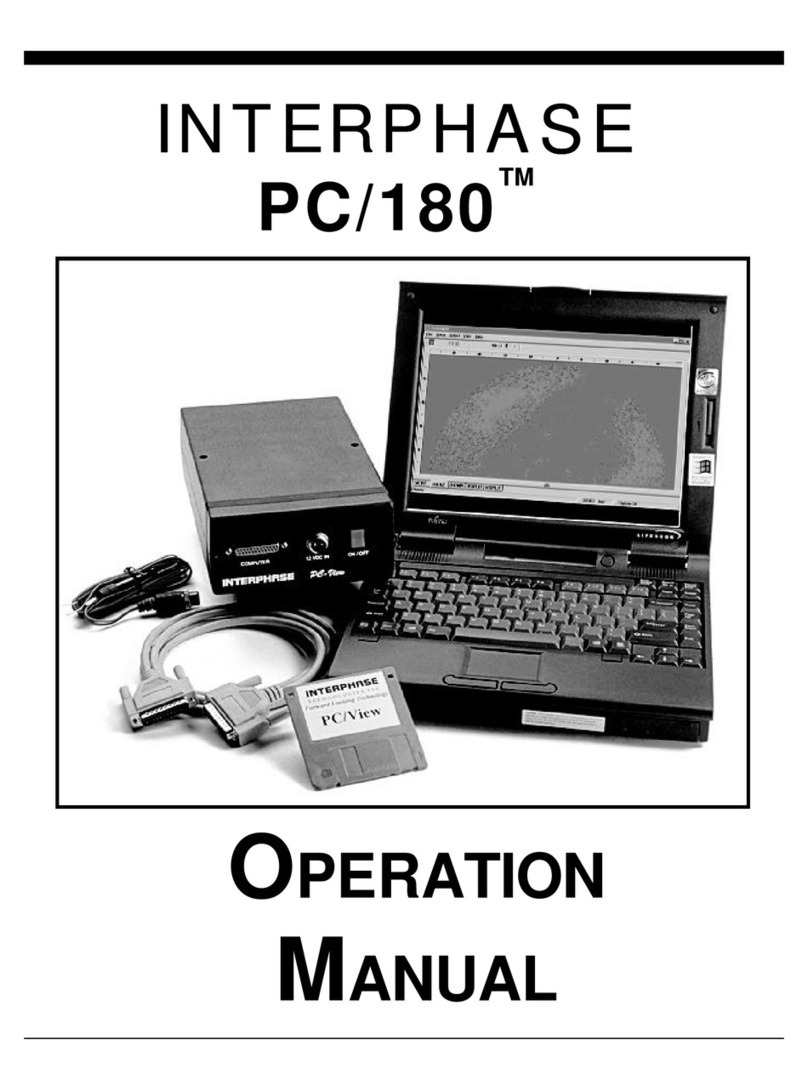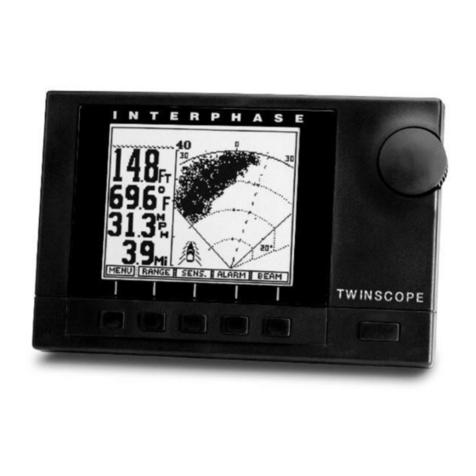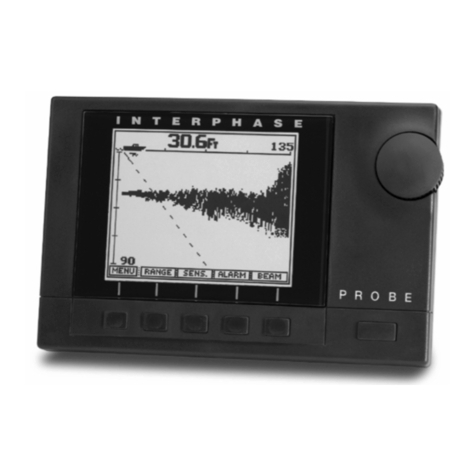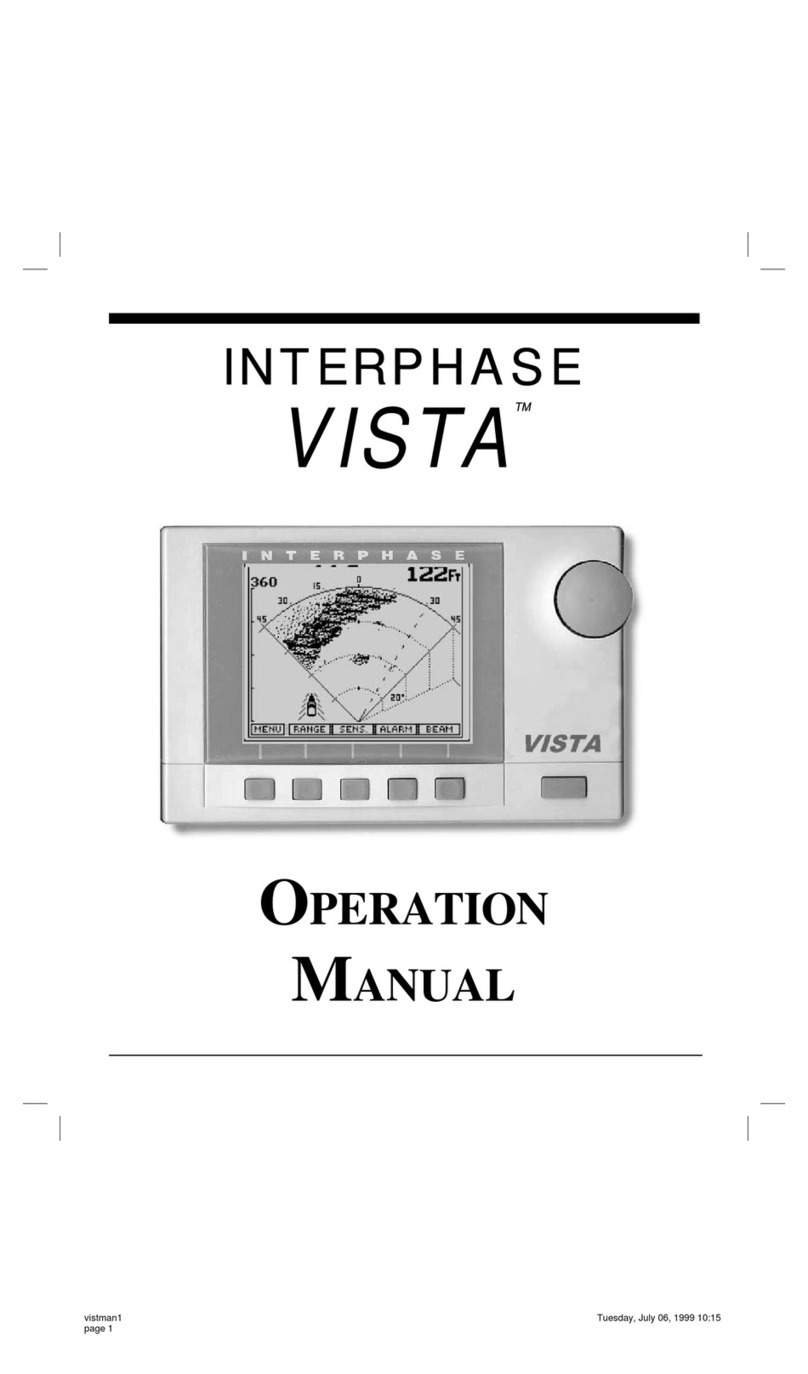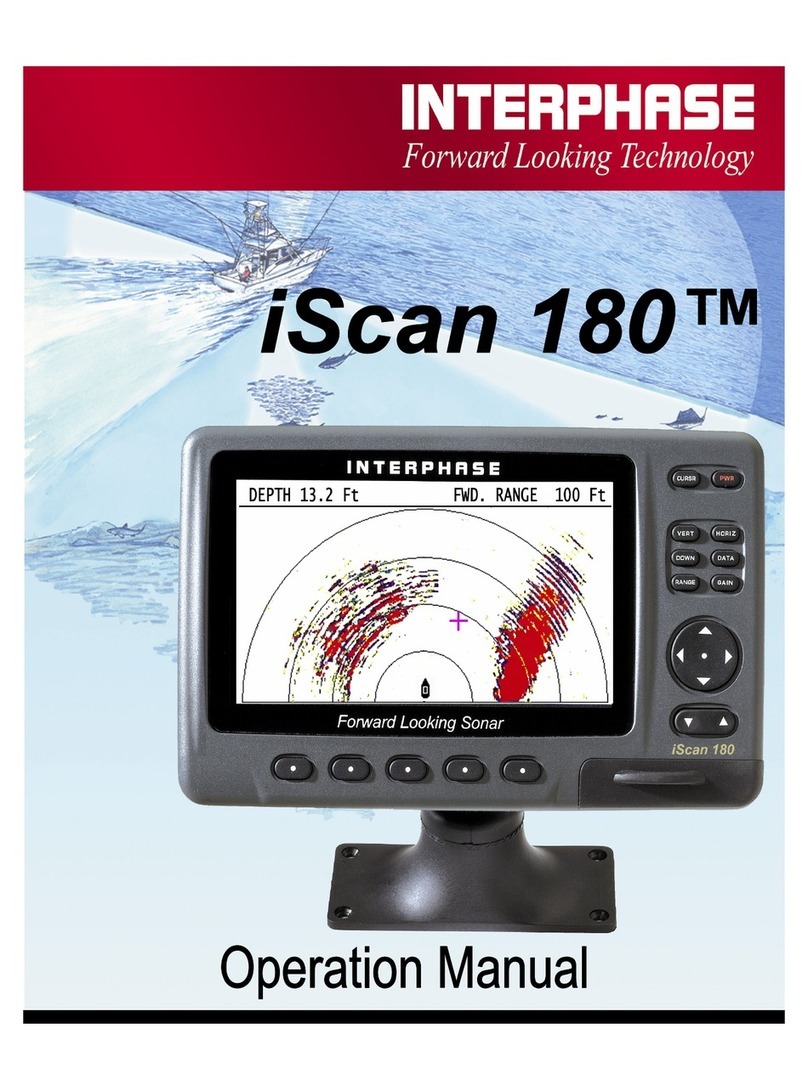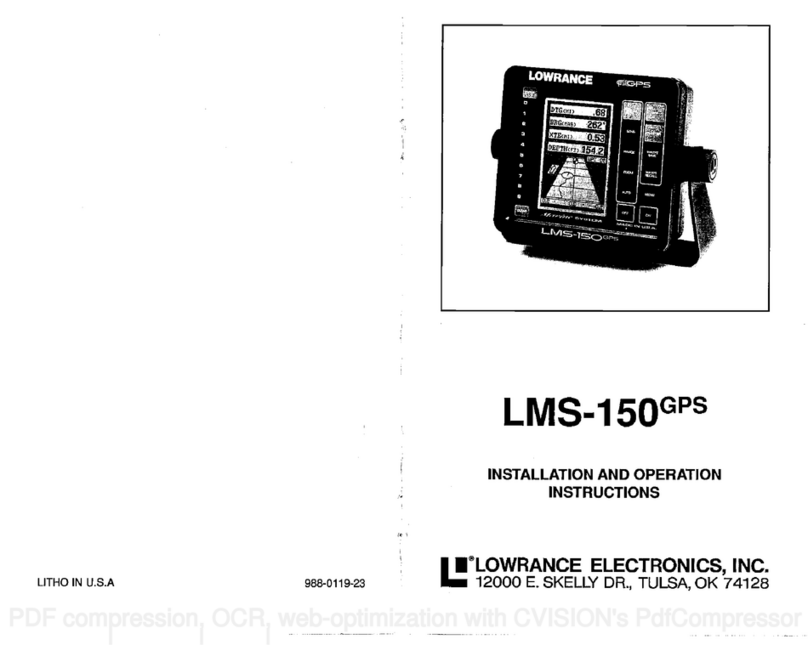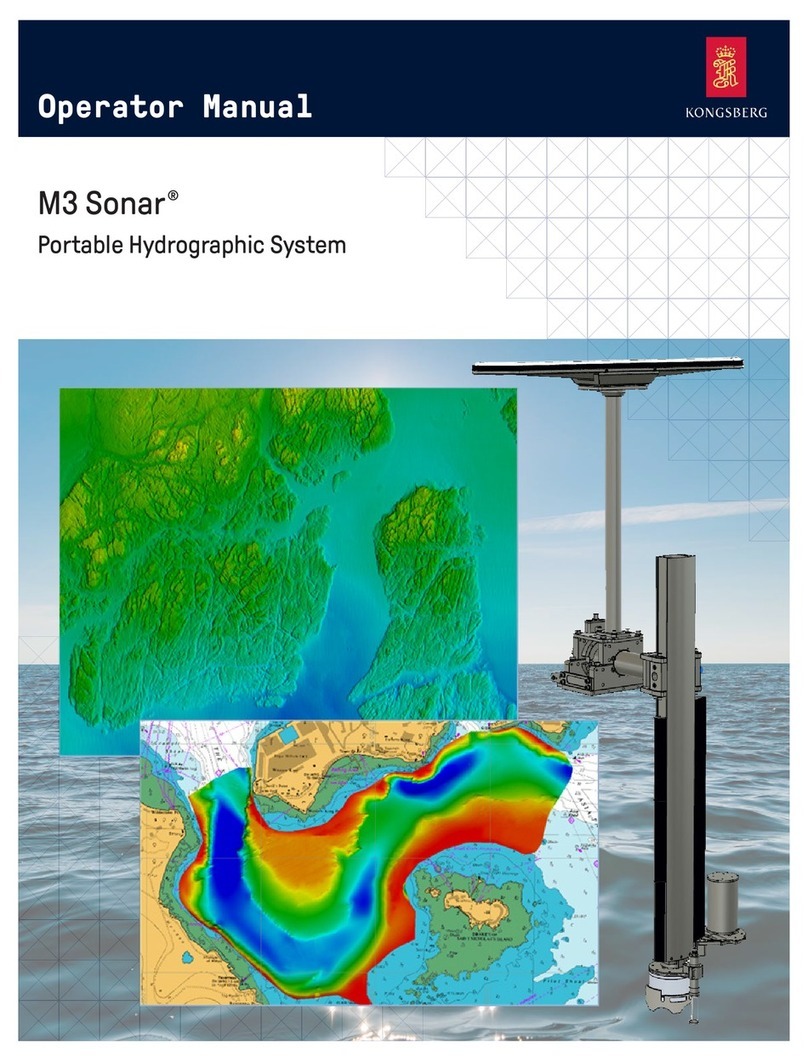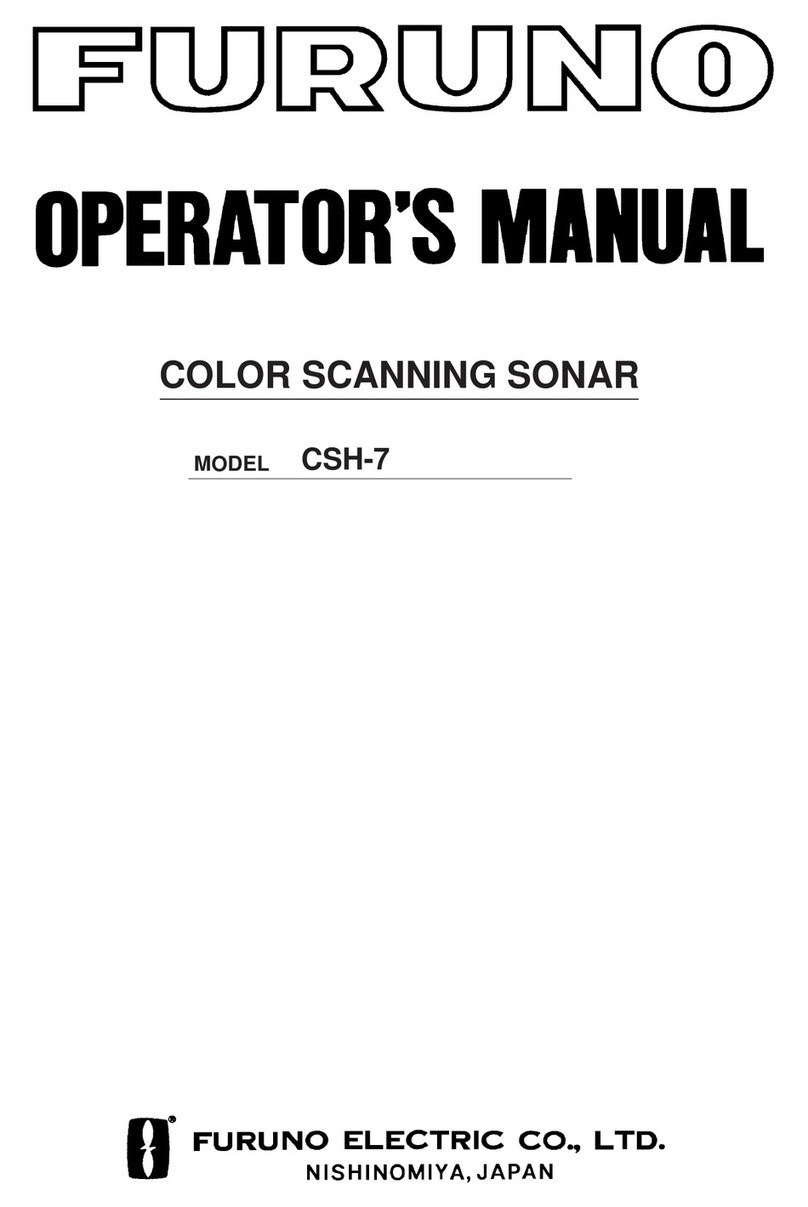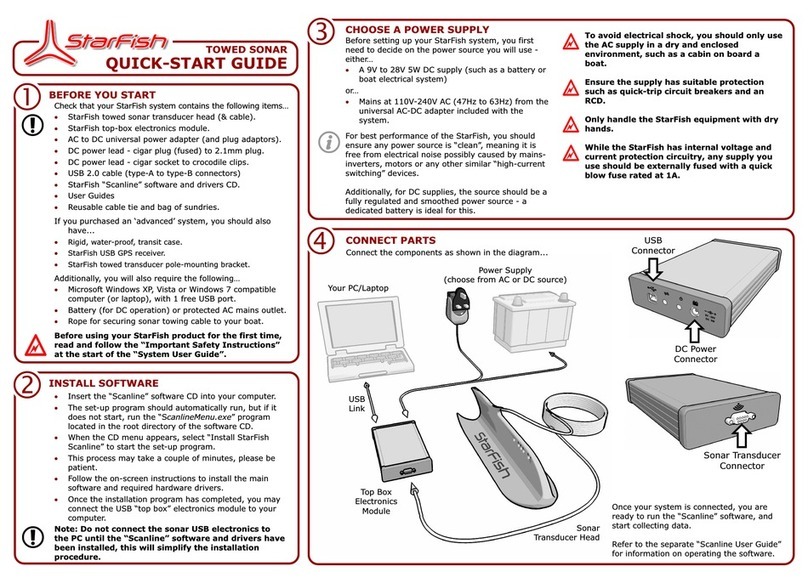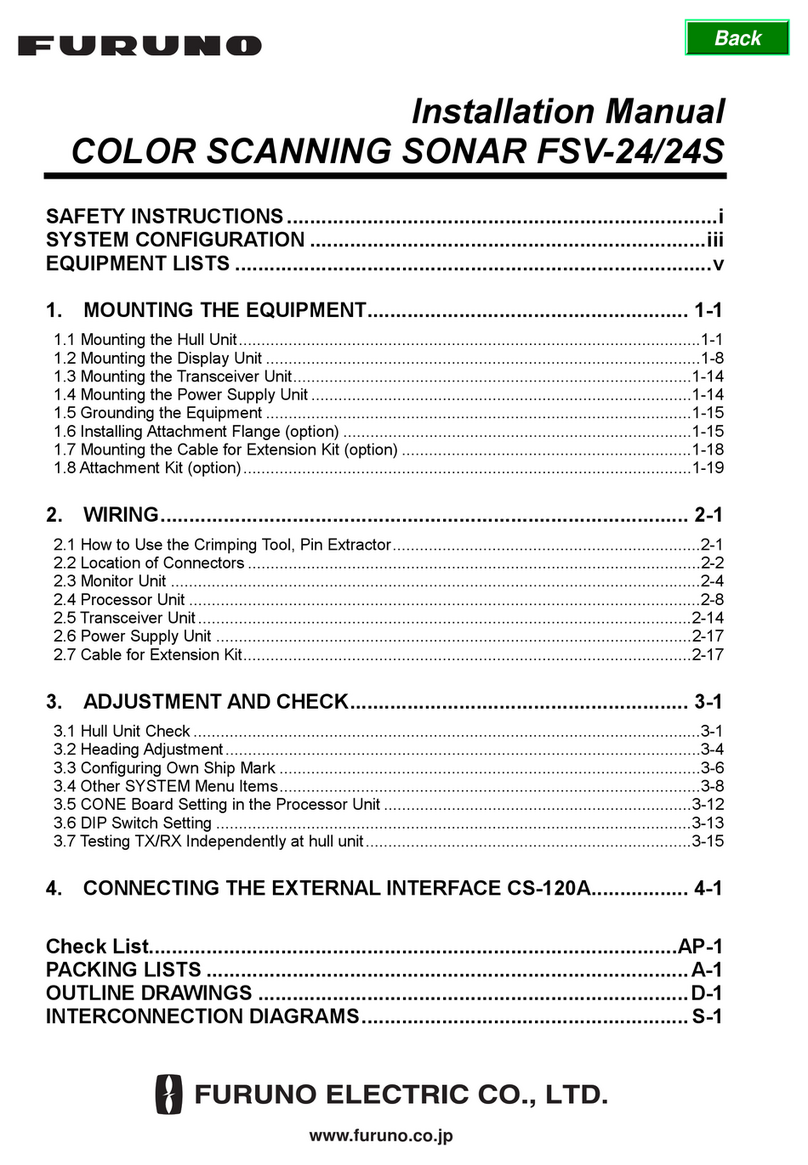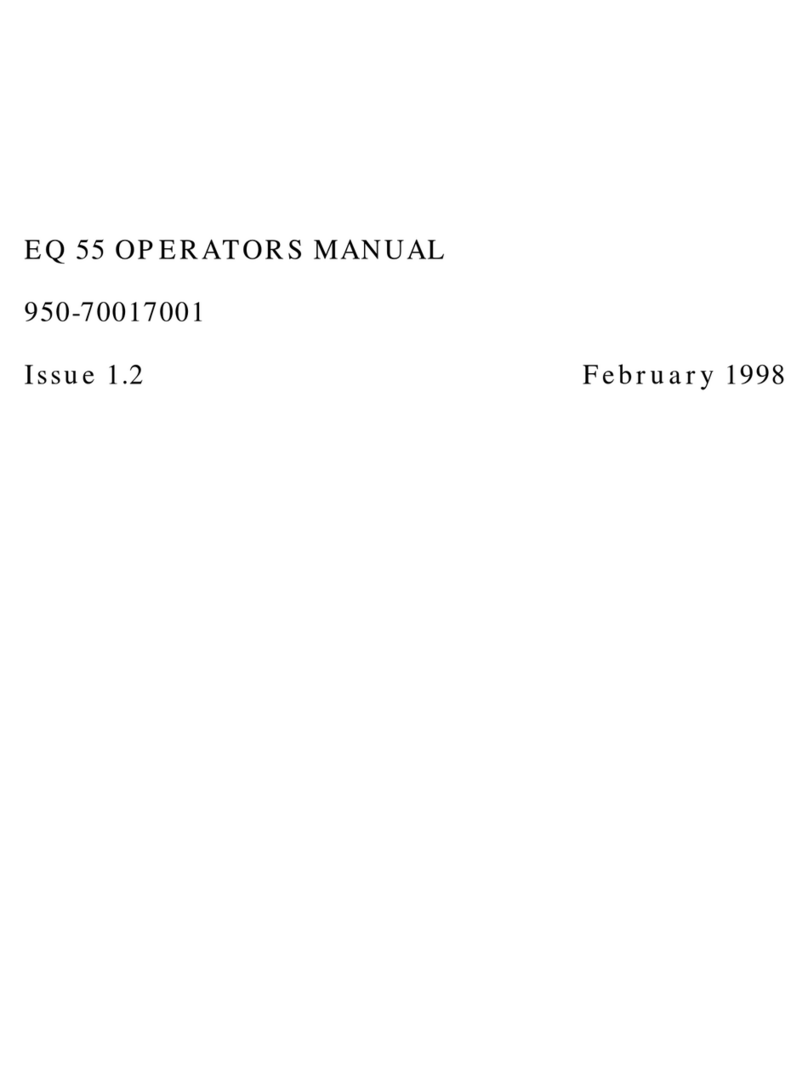Interphase Advantage User manual

1
O
PERATION
M
ANUAL
ADVANTAGE

2
To Our Customer:
Thank you for choosing the Interphase Advantage Dual Frequency Sonar. Throughout the
development of this fine product, we have been primarily concerned with creating a unit that
offers the best possible value for your money. Selection of features, ease of use, superior
performance and outstanding reliability were the benchmarks upon which all important design
decisions were made. We feel proud of the Advantage and your satisfaction is very important to
us. To this end, we welcome any comments or suggestions that you might have in regard to this
equipment.
It is very important that you complete and return the WARRANTY REGISTRATION CARD
within 15 days of purchase so that your unit may be protected under the warranty.
Sincerely,
INTERPHASE TECHNOLOGIES, INC.
©2005 Interphase Technologies, Inc.
Interphase Advantage™ is a trademark of Interphase Technologies, Inc.
Publication # = Advantage 4.3

3
Table Of Contents
Important Notice 5
Principle of Operation 6
Display Unit Installation 8
Transducer Installation 10
Basic Operation 18
Getting Started 22
Set-Up View 24
Demo Program 24
Units of Measure 24
Language Selection 25
Display Contrast 25
Plot (Track Plot) View 26
Range 26
Mark 26
Center 27
Reset 27
Transmit Power Adjustment 28
Frequency Selection 29
Chart View 30
Range Adjustment 30
Sensitivity Adjustment 30
Bottom Hardness 32
Alarm Adjustment 32
Zoom & Bottom Track 33
Fish Symbol ID & Scrolling Speed 34
Data View 35
Range Adjustment 35
Log Reset 35
Speed Calibration 35
Sensitivity Adjustment 35
Alarm Adjustment 36
Chart/Plot View 37
Range 37
Mark 37
Center 38
Reset 38
NMEA 0183 Interface 39
Interpreting the Advantage’s Display 40
Maintenance 42
Troubleshooting Guide 43
Interference Problems 44
Specifications 45
How To Obtain Service 46
Warranty 47

4
General Information
T
hank you for your selection of the Interphase Advantage
High Power Dual Frequency Sonar. The Advantage’s
ruggedly built, compact design makes it ideal for installation
on nearly any boat. It will display water depth, bottom
conditions and submerged objects such as fish, on its high
resolution display. The Advantage is available with either a
combination transom or a bronze thru-hull depth/speed/
temperature transducer.
The Advantage has an unprecedented number of advanced
features, to make your boating safer and your fishing more
productive. Its high resolution SuperTwist Liquid Crystal
Display (LCD) provides split screen views of 4X
magnification zoom and bottom lock, large digital display,
speed and temperature history graphs (with the speed/
temperature transducer). You will appreciate the very useful
features of fish and depth alarms, manual or automatic gain
control, bottom hardness indicator and fish symbol
identification.
The Advantage allows operation in your choice of nine
languages: English, French, Italian, Spanish, German, Danish,
Finnish, Swedish, or Greek. Power-off memory saves
language, depth range, gain and contrast settings, screen
advance speed and location in screen menu. Due to its unique
multi-tasking operation, the Advantage provides instant full
screen updates when switching between modes (no data loss).
If you have your Advantage interfaced with a Loran-C or GPS
unit, you can take advantage of the included track plot
displays. The Loran-C, DECCA, and GPS track plot displays
on the Advantage give a whole new dimension, by enabling
you to not only see the depths beneath your boat, but also to
see a graphic display of your boat’s position and progress over
time. The track plot display makes it easy to find and return to
the same fishing spot, or to troll back over the same productive
areas.
To ensure that you receive the maximum benefits available
from the outstanding features of the Interphase Advantage,
please carefully follow the steps outlined in this manual. An
instructive demonstration simulator has been designed into the
Advantage and we highly recommend that you spend some
time using the demo mode prior to actual use of the unit. We
also recommend that you read this entire manual before
attempting to either install or operate your Advantage.

5
Warranty Information
Interphase provides a limited warranty on the Advantage
Dual Frequency Sonar. We strongly urge you to read this
warranty (reprinted at the back of this manual) and closely
follow its terms and conditions should your Advantage require
repair. It is highly recommended that you save all packing
materials so that if you should need to send in the unit for
repair, it can be fully protected. If you wrap your display unit
in the original plastic bag and ship it in the box with cardboard
inserts, this will protect your unit from scratches and shock
during shipment. You do not need to include the mounting
knobs or mounting bracket, however, try to include the
transducer whenever possible. Do not send the power cable
with the unit unless you need it tested for continuity or correct
polarity (Pin #1 to Red Wire).
Should you experience a problem with your Advantage, first
refer to the Troubleshooting section (Page 43) of this manual.
Most common problems and their solutions are described here.
If problems persist, call Interphase Technical Service at
(831) 477-4944. We will be happy to try to assist you, and if
required, we will give you instructions on how to quickly get
your set repaired.
The enclosed warranty registration card must be completed
and returned to Interphase within 15 days of purchase so that
your unit may be protected under the warranty. Failure to
return the warranty card may cause unnecessary delays in
processing your unit for warranty repair.
WARNING
Navigation based solely on one method or
one instrument should never be practiced.
While the Advantage can be quite useful in
showing underwater structure and changing
bottom conditions below your vessel, there
are many situations and conditions which
can cause erroneous or distorted readings.
In addition, there are many situations that
can cause “blind spots” in the Advantage’s
field of view including the presence of
temperature inversion layers (thermoclines),
water turbulence, and high concentrations
of suspended particles in the water.
While the Advantage may be considered as
a useful aid to navigation, it should never be
the only means of navigation.
IMPORTANT NOTICE
As sonar technology advances, there is a
strong possibility that we will develop
many new and exciting features in the
future. We would like to make sure we can
send you information about these new
features and enhancements.
Please fill out and return the Warranty
Registration Card immediately. This is our
only method to keep in contact with you
and we may want to advise you of future
enhancements to your Advantage.
If future changes or improvements are
made, software upgrades will be available
for a nominal charge.

6
Principle of Operation
The Advantage Dual Frequency Sonar uses a proprietary
acoustic technology to develop short high energy underwater
acoustic signals that can detect submerged objects and
changing bottom conditions far below your boat. Because of
it’s extremely high pulse power and outstanding receiver
sensitivity, the Advantage can probe the water beneath your
boat to depths of 2,000 feet.
The Advantage Sonar system consists of an LCD display
module and a multi-featured dual frequency transducer. The
transducer contains a single specially designed piezoelectric
ceramic element that can operate at both 200 and 50 kilohertz.
When operating, the Advantage Display module converts a
small amount of electrical current from your battery into short
bursts of high energy electrical pulses. These high energy
pulses are fed to the transducer where they excite the dual
frequency ceramic element. When excited by these electrical
bursts, the ceramic element converts them into a strong
underwater acoustic signal. These acoustic signals travel out
from the transducer in a cone shaped pattern, called the cone
angle.
When the ceramic element in the transducer is excited with a
200 kHz electrical signal, the resulting acoustic cone angle is
approximately 15 degrees and increases to about 45 degrees
with a 50 kHz signal. When the acoustic pulse strikes an
underwater object, it is reflected back (echo return), received
by the same ceramic element in the transducer, and converted
back into small electrical impulses. These impulses are
amplified, then displayed as an image on the LCD screen after
processing by the display module’s microprocessor.
The strength of the echo, the depth of the object, and the angle
of the transducer’s beam all affect how the image appears on
the display. Other factors which affect the image include boat
speed relative to the movement and position of the underwater
target and the number of objects reflecting pulses back to the
Advantage.
The Advantage’s transducer also includes a sensor for
measuring the boat’s speed through the water and the water’s
temperature at the transducer.
Because the Advantage can operate at either 200 or 50 kHz, it
offers several advantages over single frequency depth
sounders. This is because acoustic signals at different
frequencies behave quite differently and each has it’s own

7
benefit, and drawbacks. For example:
1) 50 kHz signals can penetrate to much deeper depths
than 200 kHz signals. Even with high power, 200
kHz signals usually can not reliably penetrate
beyond 1,200 feet while 50 kHz signals can easily
reach depths beyond 2,000 feet.
2) 200 kHz signals typically give much better
resolution and definition to bottom structure in the
shallower depths. If you see a return echo from the
200 kHz signal, you can be pretty sure the object
which caused the echo is almost directly beneath
your boat.
3) 50 kHz signals cover a much wider area (cone or
beam angle) than 200 kHz signals. This can be very
useful when searching for bait, bottom structure or
even when monitoring the depths or tracking
downrigger weights.
4) 200 kHz and 50 kHz signals react differently when
they strike underwater schools of bait and encounter
temperature inversion layers. With experience, you
can use the two different frequencies to better
understand and interpret underwater signals.
The Advantage allows you to view the water beneath your
boat with either a full screen 200 kHz view, a full screen 50
kHz view or a split screen dual frequency view. In the split
screen dual frequency view the Advantage alternately pulses
the transducer with each frequency and then displays the
returning echoes.
The Advantage’s unique variable output power system allows
you to manually adjust for optimum power transmission in
either shallow or deep conditions. In shallower water you can
reduce the output power to help reduce screen clutter from
unwanted objects, while in deeper water the power can be
adjusted upwards to achieve outstanding depth penetration and
fish detection.

8
Installation
Display Unit
The compact size of the Advantage display unit allows
for easy installation in almost any vessel. To get
maximum performance and life from your unit, the
following guidelines should be considered when selecting
a mounting location:
1) Select a location where the unit is protected from
excessive temperatures. Heat is one of the worst enemies
of electronic components, and will accelerate component
aging, thereby reducing the trouble-free life of your
Advantage.
2) Mount the display in a location where it will be
convenient to route the power cord and transducer cable.
Power connection
Connect the two-pin plug on the end of the power supply
cable to the power supply jack located at the rear of the
main display unit. Connect the red wire to the positive
terminal and the black wire to the negative terminal of
your boat’s 12 DC battery.
To minimize electrical interference, carefully route the
power cable so that it does not run parallel or close to the
transducer cable, engine, refrigeration, bilge pump or any
other critical wiring.
IMPORTANT: The Advantage’s 12 VDC power leads
should go directly to the boat’s battery, distribution board,
or breaker panel. Instability of the display may result if
the unit has to share leads with other electrical systems
aboard your boat.
Wiring for Power and Transducer
Connectors
The correct pin-out wiring sequences for the power and
transducer connectors are shown at right. DO NOT
SHORTEN THE TRANSDUCER CABLE. If a
transducer cable longer than the 30’ length supplied with
your unit is needed, please contact your Interphase
dealer. A 30-foot transducer extension cable is available.
(P/N # 04-0009-008)
Shelf/Table
Overhead
Panel Flush Mount Installation
Optional flush mount bracket available
Interphase part # 17-0054-008

9
DANGER: Removal of any connector, disassembly of
transducer, shortening of any cable or use of any cable
other than that supplied by Interphase will void your
warranty (no exceptions).
Cable Connectors
(view from front of female plug)
9 Pin Spare:
(Not Used - reserved for
future use)
8 Pin Transducer:
1 Speed Data
2 +5VDC
3 Depth element
4 Depth shield
5 Depth element
6 +Temp. Sensor
7 -Temp. Sensor
8 Shield/Ground
Power Connector:
1 +12 vdc
2 - (Ground)
NMEA Input:
1 Data
2 Return ( Ground)
3 N/C
N/C = No Connection
12 Volt Battery
Red Wire NMEA 0183
Input (3-pin)
Spare
(9-pin)
12 VDC
Power Cable
(2-pin)
Transducer:
Depth /
Speed /
Temp.
(8-pin)

10
Transducer Installation
The Advantage comes standard with either a transom
mount or thru-hull style transducer. The transducer
includes both a speed and temperature sensor which
allows the Advantage to display current boat speed,
surface water temperature and elapsed distance in
addition to the depth below the boat.
IMPORTANT: If for any reason you prefer another type
of transducer available through Interphase, we will
exchange your unused transducer for one of your choice.
In some cases an additional cost may apply. Contact
Interphase’s Accessory Sales Department (831) 477-
4944, extension 14 for additional information.
The Advantage’s transducer contains a single ceramic
element which will operate on both the 200 kHz and 50
kHz frequency. The Advantage has an amazing amount
of capabilities, but it can not perform magic. It can not
see through objects such as your boat’s hull. Therefore, it
is important to position the transducer so that it has as
clear a view as possible of the water below your boat, as
indicated in the top left illustration.
The sketch at left shows the proper orientation for both
the transom mount or the thru-hull transducer.
General Considerations
DO NOT CUT OR SPLICE YOUR TRANSDUCER
CABLE OR REMOVE THE 8-PIN CONNECTOR .
THIS ACTION WILL VOID YOUR WARRANTY.
If you need a longer length cable than comes with the
transducer (30’), then purchase the optional 30’ extension
cable, Interphase Part # 04-0009-008.
In addition to the above, the following considerations
should be observed:
1) Choose a location where there is the least
amount of acoustic noise, air bubbles or turbulence
caused by the boat’s movement. The transducer should
not be located nearby or especially directly behind the
propeller.
Dual Frequency (Two Cone Angles)
200 kHz
50 kHz
Transom Mounted Transducer
Thru-Hull Transducer
Front
Front

11
2) Choose a location where the transducer can be
mounted so that it will be level to the water’s surface and
will not be tilted to either side.
3) The transducer must always remain submerged,
regardless of the speed of the boat and should not be
mounted where it could be damaged by underwater
obstacles or when loading on a trailer.
4) DO NOT locate the transducer in the extreme
bow of the boat where it will be subject to intense
turbulence as the boat pounds through the water.
5) DO NOT locate the transducer directly behind
any hull protrusion which will cause the water to be
turbulent when it reaches the transducer. For
displacement-hull power and sail boats, the thru-hull
installation is usually required.
DANGER: DO NOT allow any solvents, i.e. gasoline,
acetone, to come in contact with the transducer or head
unit as this may dissolve the plastic material.
Transom Transducer Installation
The transom transducer is attached to the boat with two
stainless steel brackets. The brackets should be mounted
to the ears on the top of the transducer using the hardware
supplied. All metallic parts are stainless steel to resist
corrosion. Good operation up to 40 - 50 MPH is usually
possible. Obtaining operation at higher speeds is possible
but may require considerable experimentation with
transducer positioning.
Transom Mounting Location
On single drive installations, it is strongly recommended
that the transducer brackets be mounted on the side of the
boat where the propeller blade is rotating downwards
which usually is the right (starboard) side. To reduce the
possibility of disturbing the water flow to the propeller,
the transducer should be located about 2” outside the
swing of the prop. If possible, the transducer and bracket
should not be mounted directly behind any strakes, ribs,
intakes and outlets for live wells and/or engine cooling
water, or any protrusion which may cause turbulence or
cavitation. For dual engine installation, just off the center
line is usually acceptable.
30’ Extension Cable
8-pin
Male 8-pin
Female
Interphase Part #
04-0009-008
Transom Mount Locations
18 - 24"
Cables
Twin Outboards
Transducer
Cable

12
Attaching the Transducer to the Bracket
Assemble the mounting bracket to the transducer using the 4
screws, washers and lock nuts provided. The bracket arms
must be mounted outside the plastic mounting ears of the
transducer. Do not fully tighten the lock nuts at this time.
Mounting the Transducer to the Boat
1) Place transducer and bracket at the selected location
on the boat’s transom. Align the bracket so that the bottom
surface of the transducer is about 1/4” below the underside of
the boat’s hull. (See figure at bottom left). Good results can be
achieved on most boats when the bow of the transducer is
about 1/4” below the hull. It is not recommended to place the
transducer further down than necessary because it increases
drag and spray, reduces boat top speed and increases water
noise generated by the transducer.
2) Mark an outline of the slot locations on the hull.
Mark the screw locations in each slot outline as shown in the
sketch at the top left of the following page. Drill four holes,
each 1/2” to 5/8” deep using a 9/64” drill. (Masking tape
wrapped around the drill 5/8” back from the point is one
method to prevent drilling too deep.) Also, in fiberglass hulls,
chamfer the gelcoat to prevent surface cracks. Drilling first
with a 1/4” drill about 1/8” deep is an easy way to prevent
surface cracks.
3) Using the four panhead sheet metal screws provided,
attach and tighten the bracket to the hull so that the transducer
projects 1/4” below the underside of the hull. Align the fore/
aft angle of the transducer so that the rear is approx. 1/8” lower
than the forward point. (See figure at right on following page).
Tighten the four transducer bolts and the four sheet metal
screws.
4) Route the cable to the Advantage display being
careful not to tear the cable jacket when passing through
bulkheads, etc. To reduce electrical interference, keep the
transducer cable separated from ignition, tachometer,
alternator or other electrical wiring. Secure the transducer
cable in place with “tie-wraps” or lacing twine.
5) Do not remove the connector or cut or splice the
cable to ease cable routing. Either cut holes large enough to
pass the connector or choose a different route to the display.
Connector removal or cable splicing voids the transducer
warranty. Flake out any excess cable and secure in place.
Rear View
Side View
Attach Brackets to Transducer
Boat’s Hull
1/4”
Bottom of Transducer 1/4” Below Bottom of
Hull

13
Testing
After connecting the transducer to the Advantage display, a
test of installation should be conducted. After becoming
familiar with the Advantage’s performance at speeds of 5 to 6
knots, gradually increase your boat’s speed. As the boat speed
increases, there will be a gradual degradation of the
transducer’s performance because flow of water over the
transducer generates acoustic noise. If you’re in the manual
gain mode (not Auto Gain), you may have to increase the gain
setting to get a clear bottom reading. When aeration of the
transducer occurs, the degradation is usually not gradual, but
sudden. If this occurs, note the boat’s speed and gain setting at
the onset of the degradation. Remove the boat from the water
and recheck the alignment of the transducer. If necessary,
readjust the bracket to make sure the rear of the transducer is
approx. 3 to 5 degrees (1/8”) below the front as shown in the
sketch at bottom right. If the transducer alignment is correct,
then lower the transducer 1/4” further below the hull and
repeat the test. If still unsatisfactory, try a new location closer
to the center keel where aeration is usually less pronounced.
Remember to fill unused screw holes with sealant.
To overcome the effect of surface roughness on aluminum
boats, it may be necessary to move the transducer down so that
it projects 1/2” to 3/4” below the transom. On a few hull types
specifically designed to direct air under the hull, moving the
transducer away from the keel can improve performance.
3 degrees
Line of Hull
Attach Brackets To Stern Of Boat
Bottom of Boat’s
Hull
Angle Rear of Transducer Slightly (3 to 5
degrees) Below Front.
Mark Hull
Before Drilling

14
Thru-Hull Transducer Installation
The thru-hull transducer is the recommended choice for
larger boats with in-board engines. Thru-hull mounting is
usually required on larger power and sail craft. The
Advantage must have a clear view of the water below as
it can not magically see through obstructions such as the
vessel’s hull. Please read the following carefully before
starting the thru-hull installation.
Normally, thru-hull installations are performed by a
professional in a boat haul-out facility and you may want
to seek professional assistance before attempting to mount
this transducer.
Selecting the Best Location
The best location to mount the thru-hull transducer will
vary with the type of boat. Try to find a location with the
smallest dead rise angle to make installation easiest.
Consider that from time to time you will need to
remove the speed/temperature plug (from within the
vessel) in order to clean the speed paddle wheel. Make
sure you choose a location that is easily accessible
from inside the vessel!
a. On displacement hulls (sailboats, trawlers, etc.) locate
the transducer about 1/3 aft along the waterline.
Generally this provides the best compromise between
obtaining aeration-free water and minimizing propeller
noise. The Advantage’s transducer can not see through
aerated water and water near the bow and near the keel
can be quite aerated. Aeration of the transducer can be
minimized by keeping the transducer mounted away from
the keel and by not mounting too far forward.
b. On sailboats, the transducer should be mounted where
the acoustic beam will not be shaded by the keel. Try to
find an accessible spot with a minimum dead rise angle.
c. On planing powerboat hulls, the transducer should be
mounted well aft and close to the keel to insure that the
transducer is in contact with the water at higher speeds.
On I/O’s, transducer mounting close to the
engine usually yields good results.
(Transducer in front of propeller.)
On inboards always mount the transducer
well ahead of the propeller(s). Turbulence
from props can seriously degrade perform-
ance.
(Thru-hull installation is recommended.)

15
d. Mount the transducer on the side of the hull where the
propeller is moving downwards. The upward motion of
the propeller generates pressure waves and
pushes bubbles up against the hull which can then flow
across the transducer’s face causing a loss of signal.
DO NOT install a bronze transducer housing directly into
an aluminum or steel hull because electrolytic corrosion
will occur.
IMPORTANT:
1) Make sure the water flow across the thru-hull
transducer is bubble and turbulence free at all speeds if
good performance is to be achieved.
2) Make sure the transducer has an unobstructed view of
the water below the boat.
3) On displacement-hull power boats, the transducer
should be mounted relatively close to the center line of
the hull.
4) Mount the transducer in a place which has reasonable
access from inside the vessel since the transducer’s speed/
temperature plug will need to be removed from time to
time. Also, during installation, the bronze nut will require
tightening from inside the hull.
The transducer must be mounted so that it’s bronze stem
is as perpendicular to the water line as possible. If
necessary, use a fairing block to properly position the
transducer.
Use of a Thru-hull Fairing Bl
ock
Nearly all vessels have some dead rise angle at the
transducer mounting location. If the thru-hull transducer
were mounted directly to the hull, the sound beam would
be tilted off the vertical at the same angle as the dead-rise.
Most thru-hull installations will require a fairing block to
insure the transducer is mounted properly.
A fairing block is typically made of teak or mahogany
wood or plastic and should be glued between the
transducer and hull (both inside and outside) to insure that
the transducer’s mounting shaft is perpendicular to the
water’s surface. Make the fairing block as smooth as
possible, and not bigger than the transducer’s face, to
minimize possible turbulence (see next page).
Suggested Thru-Hull
Transducer Locations
Fin Keel
Planing Hull
Displacement Hull

16
After cutting the fairing block, trial fit the block to the hull. It
is very important that the flat top surface of the transducer be
parallel to the water.
Installing the Thru-hull Transducer
1) Drill a 1/8” pilot hole from inside the hull to assure access
to tighten the housing nut and clearance for the transducer
cables. If there is any hull irregularity near the selected
mounting location, it may be desirable to drill from the
outside.
2) Use a 2” hole saw and drill the hole from the outside of the
hull. Sand or clean the area around the hole, inside and outside
to insure that the sealing compound will adhere properly to the
hull. Select a marine grade bedding/caulking compound and
use according to the instructions.
3) Remove the bronze hex nut from the housing and cable.
4) Uncoil the transducer cable and thread it through the hole
into the inside of the hull.
DANGER: DO NOT apply tension to the transducer cables
as this may sever internal connections. Apply a 1/8” thick
layer of sealant on the upper flat surface of the bronze housing
and fairing block (if used).
5) From the outside of the hull, push the cable and housing
into the 2” hole. Twist the housing slightly to squeeze out
excess sealant. Carefully confirm that the transducer is aligned
so that the rounded end (the front) is pointed directly toward
the front of the boat.
6) Install and tighten bronze hex nut (allow for swelling in
wooden hulls). Do not overtighten nut - especially if a
wooden fairing block is used as it will expand in water.
7) Remove excess sealant from the outside to assure smooth
water flow over the transducer.
DANGER: Wood hulls and fairing blocks will expand after
the boat is put back into the water, so it is important that the
transducer be only hand-tightened until the wood fully
expands. Otherwise the wood fairing block may crack.
DANGER: Be sure to check for leaks when the boat is placed
in the water. Allow at least 24 hours after installation for any
leak to appear.
Hull
Hull
Waterline
Transducer
Mount Transducer so it is Vertical
Hex Nut
Fairing
Block
Fairing
Block

17
DANGER: If the boat is kept in saltwater or in an area with
excessive marine growth it is recommended that the transducer
be coated with an anti-fouling paint. USE ONLY WATER
BASED ANTI-FOULING PAINT. DO NOT USE
KETONE BASED PAINTS. Ketone based anti-fouling paint
will attack the plastic materials used in the transducer. See
page 42 for a list of tested paints. This is not an exhaustive
list. If you are using other paints, verify with the paint
manufacturer that the paint does not react with urethane
plastic.
Transducer
Wood or
Plastic
Fairing
Block (Add
sealing
compound
between
fairing block
& hull).
Boat’s
Hull
Bronze Hex Nut
Outer part of
fairing block

18
Basic Operation
The Advantage has been designed to be as easy to learn and
operate as possible. The raised push-button keys provide a
tactile feel to each operation and the Advantage responds with
an audible beep each time a key is pressed. All keys necessary
for operation of the unit are on the front panel. The Advantage
uses a unique approach called “soft keys” along the bottom of
the display. These five keys are labeled by the LCD display and
are controlled by the unit’s software, thus the name “soft keys”.
In addition, a large front panel rotating knob eliminates the need
for multiple button pushes while making gain, depth range,
display contrast and many other adjustments. The knob
provides easy and quick adjustments while giving the user a
familiar style of operation.
The “soft key” buttons allow very easy operation as they almost
guide you along, even though the Advantage possesses an
amazing number of advanced sonar features. It would take a
considerable number of additional buttons and greatly add to the
unit’s operational complexity if each function had a dedicated
button instead of using the “soft key” approach. In addition, the
use of “soft keys”, coupled with the front panel adjustment
knob, allow for easy future software upgrades which may
include new important features. The use of fixed, permanently
labeled buttons would severely limit any future upgrade ability.
User Interface
The Advantage is a very advanced product with many features
never before found on marine instrumentation. In order to
provide these sophisticated new features while continuing to
keep user operation simple and easy to learn, several new design
approaches were adopted. Some of the more significant
approaches are described in the following.
Multi-Tasking Operation
The Advantage’s Multi-Tasking operation was developed to
make sure your time would not be wasted whenever you change
screen displays. When changing displays with other
conventional systems, the microprocessor has to completely re-
assemble a new display picture which can take a considerable
amount of time. These time delays can be very frustrating and
are unnecessary if a Multi-Tasking operating system is used.
Interphase Advantage
Short-cut
In this manual you will find
instruction on how to change all
adjustable settings by using the
“soft keys”. However, any setting
adjustment can be done (when the
appropriate menu selection is made)
by turning the control knob.
Settings which can be adjusted by
using the control knob include:
Range
Alarm
Contrast
Sensitivity
Zoom
Output Power
Frequency Select
LCD screen contrast can be changed
any time while in the Control
Center simply by turning the
control knob.
soft key Power On/
Off

19
Pre-Programmed Screen Displays
Rather than ask you to “build” different screen displays while
operating the unit, the Advantage has seven of the most
valuable LCD screen displays pre-programmed into its
operating system memory. Thanks to the Multi-Tasking
operating system, each of these pre-programmed displays
(known as Views) are always being updated, regardless of
which screen display is presently being used. This means, for
example, that the two Track Plotter’s will continue to plot and
update your vessel’s position - even while you’re looking at a
Zoomed picture of the bottom! Similarly, even while viewing
your vessel’s position on one of the Track Plot displays, the
digital and graphic depth screens are simultaneously being
updated in the background - ready for immediate access. And,
thanks to the lithium battery memory backup, as described in
the next section; ranges, gain, zoom and other settings are
remembered as you go from View to View and are even
remembered when you turn the unit off.
Internal System Memory
There is nothing so frustrating as having your depth sounder
re-start when you start your boat’s engine and having to
completely re-set the range, gain, contrast and all your other
settings. Because the Advantage contains an internal lithium
memory battery, it remembers all system settings with the
power removed. When you turn your Advantage on, it will
immediately start in the last View that you used, complete with
the proper range, zoom, gain and other important settings.
Instead of using a non-volatile RAM, a lithium battery was
used to ensure a long error-free memory life. Most non-
volatile RAM’s exhibit increasing errors with time and can
become a serious problem after only 100,000 operations.
Cold Cathode back light
The Advantage has the best LCD back light system available.
It uses a Cold Cathode Fluorescent lamp (CFL) with
exceptionally long life characteristics which greatly exceed the
more common electro-luminescent and incandescent bulb back
light. In addition to its exceptional reliability, the cold cathode
lamp provides a much more visible display than other back
light systems. Screen clarity and contrast are greatly
enhanced. The typical half-life (when output brightness
diminishes to 1/2 its original value) of the cold cathode back
light is in excess of 20,000 hours. A typical electro-
luminescent panel, for comparison, has a half life of only 2,000
hours!
Interphase Advantage
Control
Knob
Pre-Programmed Screen Displays

20
Common Soft Key Functions
The Advantage’s innovative Multi-Tasking operating system
is controlled through the Control Center, where several
different screen displays (views) can easily be selected by the
push of a button. Each of these screens (views) reside in the
Advantage’s internal memory and all are being updated in the
background, regardless of which screen is currently being
displayed. This allows the Advantage to provide instant full
screen displays of different features with no data loss on other
screens.
On many of the display screens you will note a recurrence of
the left most soft key labeled “MENU”. When the MENU
soft key is pressed, the Advantage will return to the Control
Center display. Use of the MENU soft key is required in
order to return to the Control Center where another mode of
operation (i.e. normal depths, track plotting, etc.) can be
chosen.
Power/back light Key
Press the "Power/back light" key located at the lower right of
the unit to turn the Advantage on. The unit will respond with
an audible beep when it turns on. Pressing this key again turns
the back light on and off, each time accompanied by a beep.
To turn the Advantage off, press this key and hold it down for
several seconds until the unit goes off.
Simulator/Demo Mode
Your Advantage includes a built-in DEMO simulator
program which makes it easy to practice with the unit and to
get a feeling for its many features before actually using it in
real situations on the water. We highly recommend you run
through this section on operation of the Advantage with the
DEMO mode activated to first learn basic feature controls.
The DEMO mode can be started from the SETUP menu as
described in the following section.
Split Screen Displays
The Advantage has several different split screen display
capabilities such as Split Screen Zoom, Split Screen Chart and
Data and Split Screen Chart and Track Plot, among others. It
is important to realize that whatever is displayed on the right
side of the display is the PRIMARY information. This means
that when you are in split screen displays, the soft key menus
will usually only relate to the right side of the display.
Control Center Softkey Menu
Typical Sub-Menu
Table of contents
Other Interphase Sonar manuals
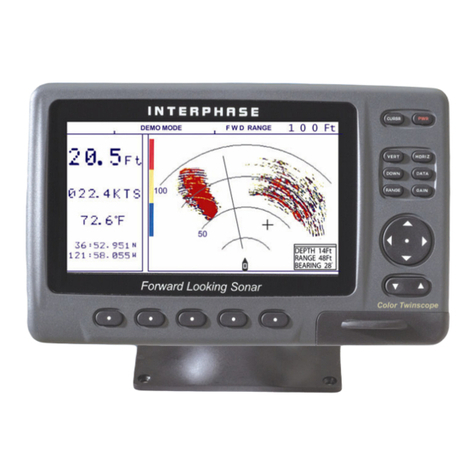
Interphase
Interphase Color Twinscope User manual
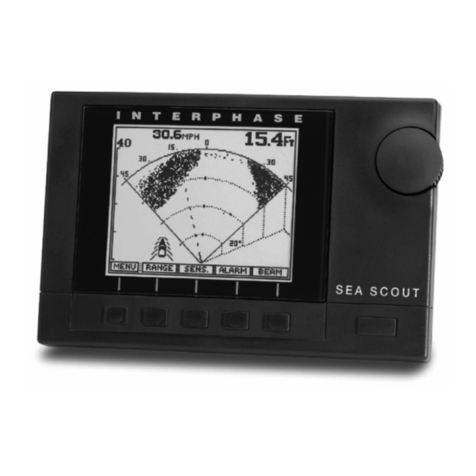
Interphase
Interphase Sea Scout User manual
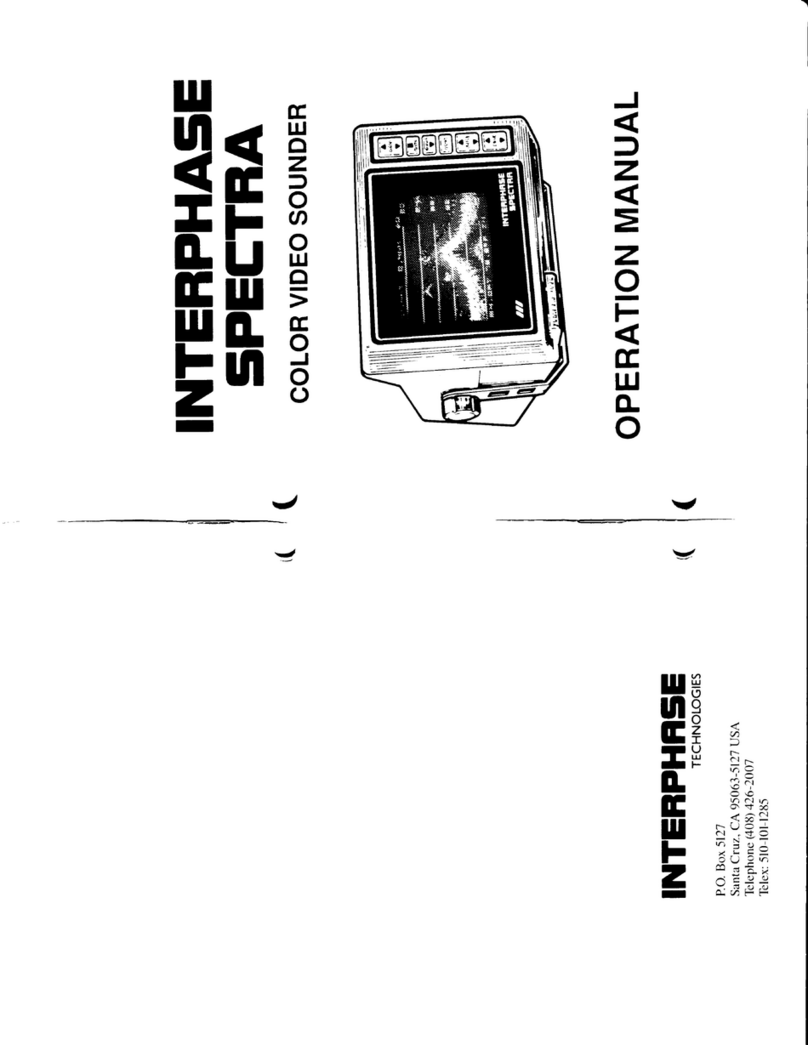
Interphase
Interphase Spectra User manual
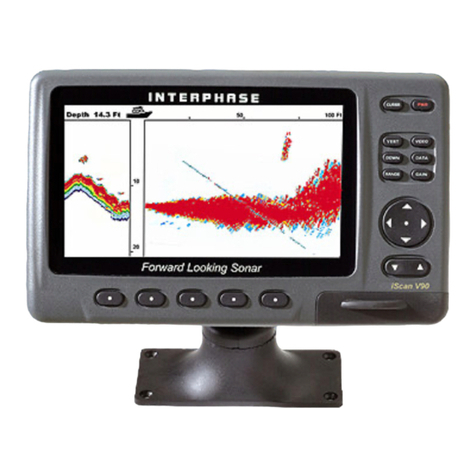
Interphase
Interphase iScan V90 User manual
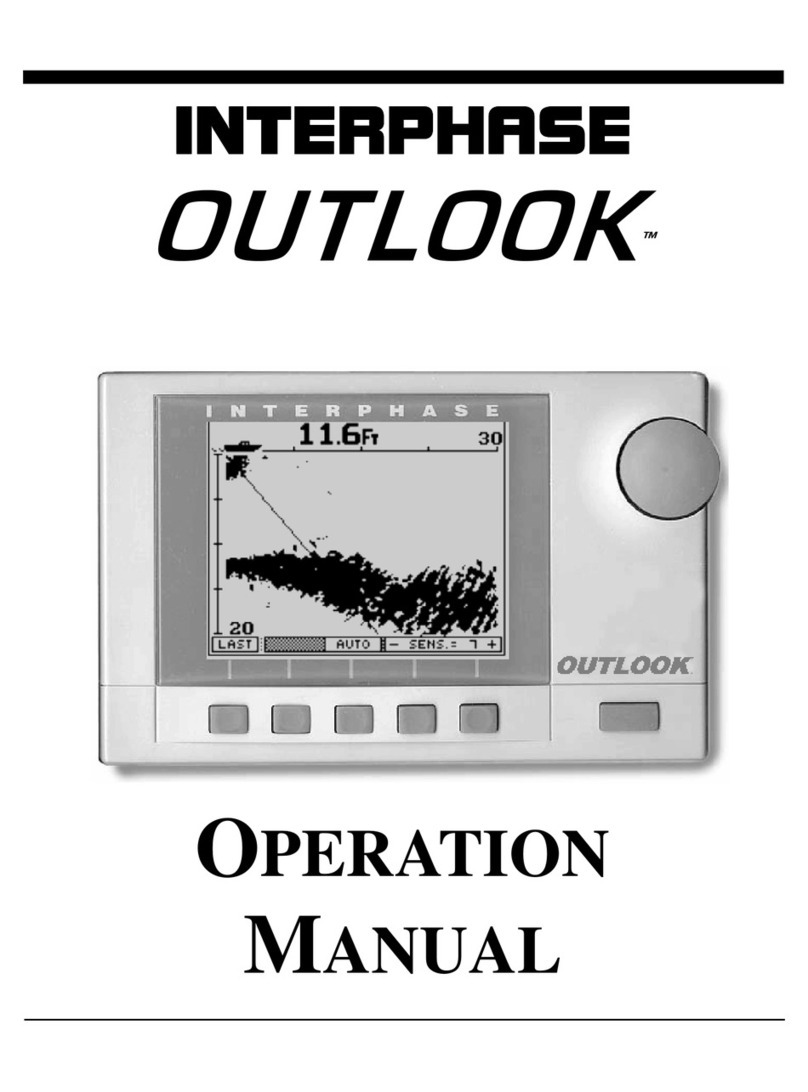
Interphase
Interphase Outlook User manual
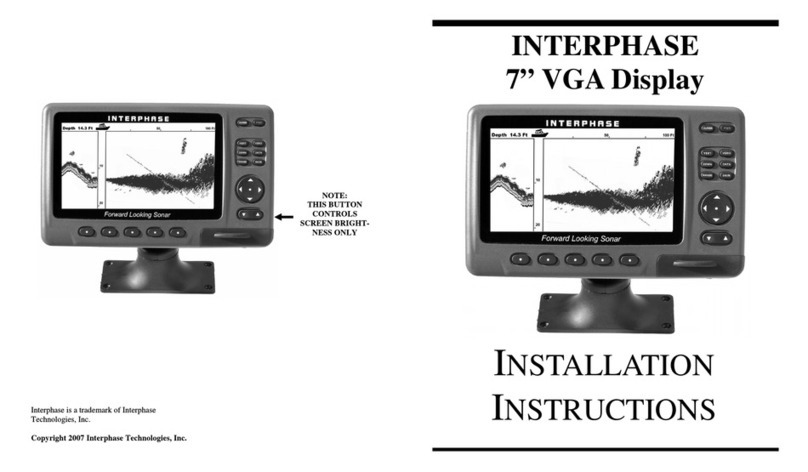
Interphase
Interphase Sonar Engine SE-200 User manual
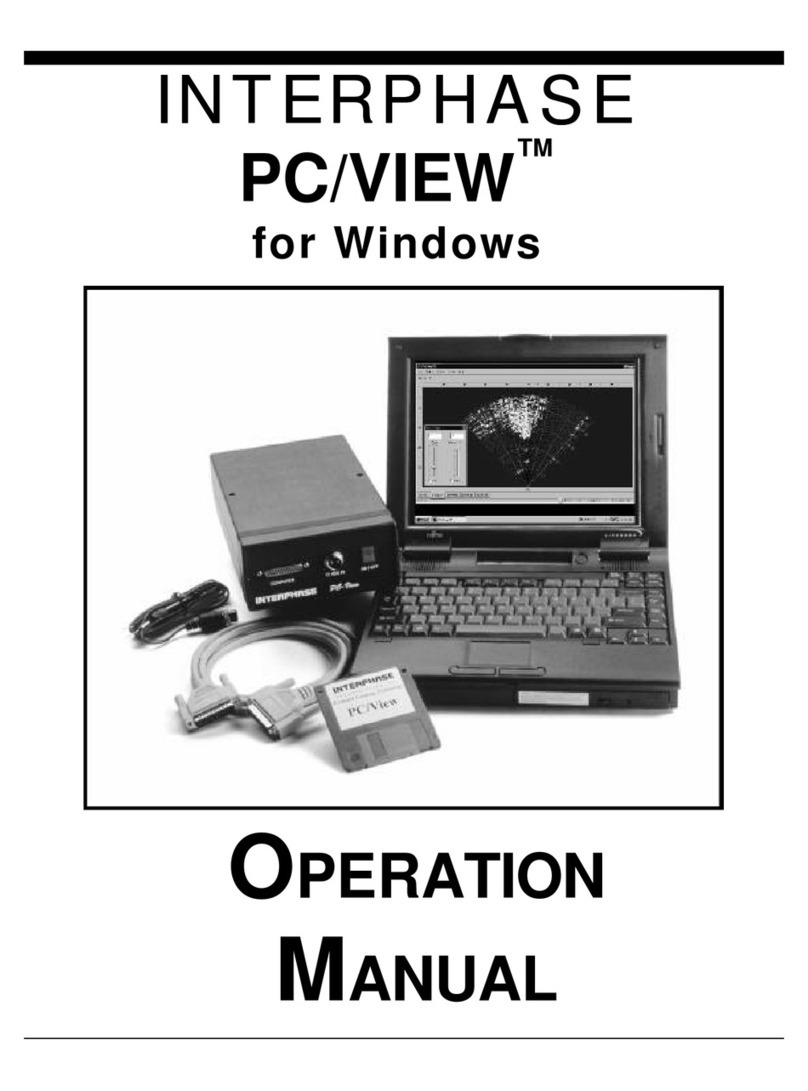
Interphase
Interphase PC/View User manual
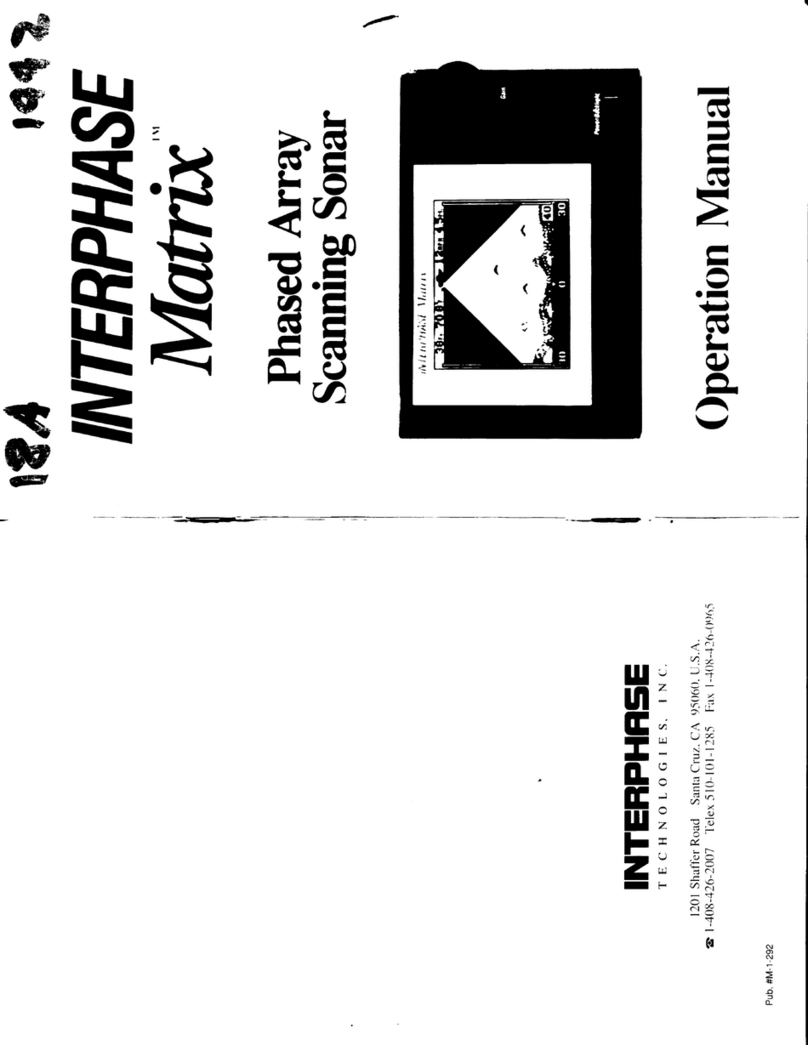
Interphase
Interphase Matrix User manual
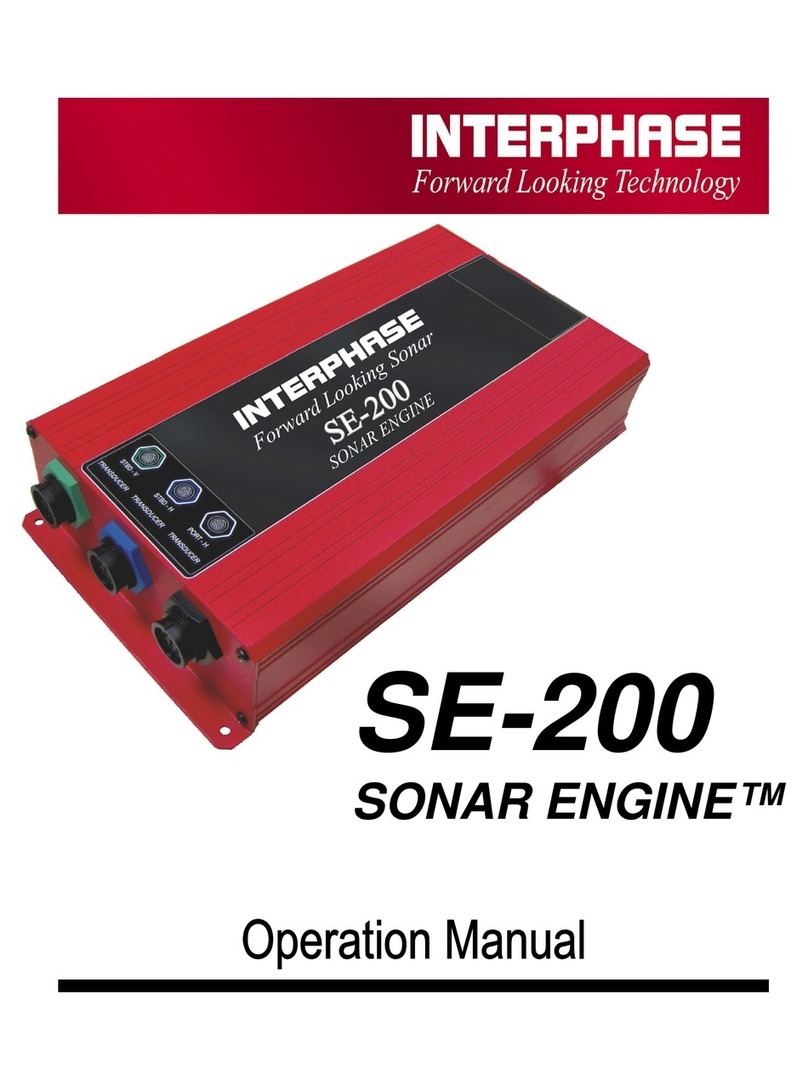
Interphase
Interphase Sonar Engine SE-200 User manual
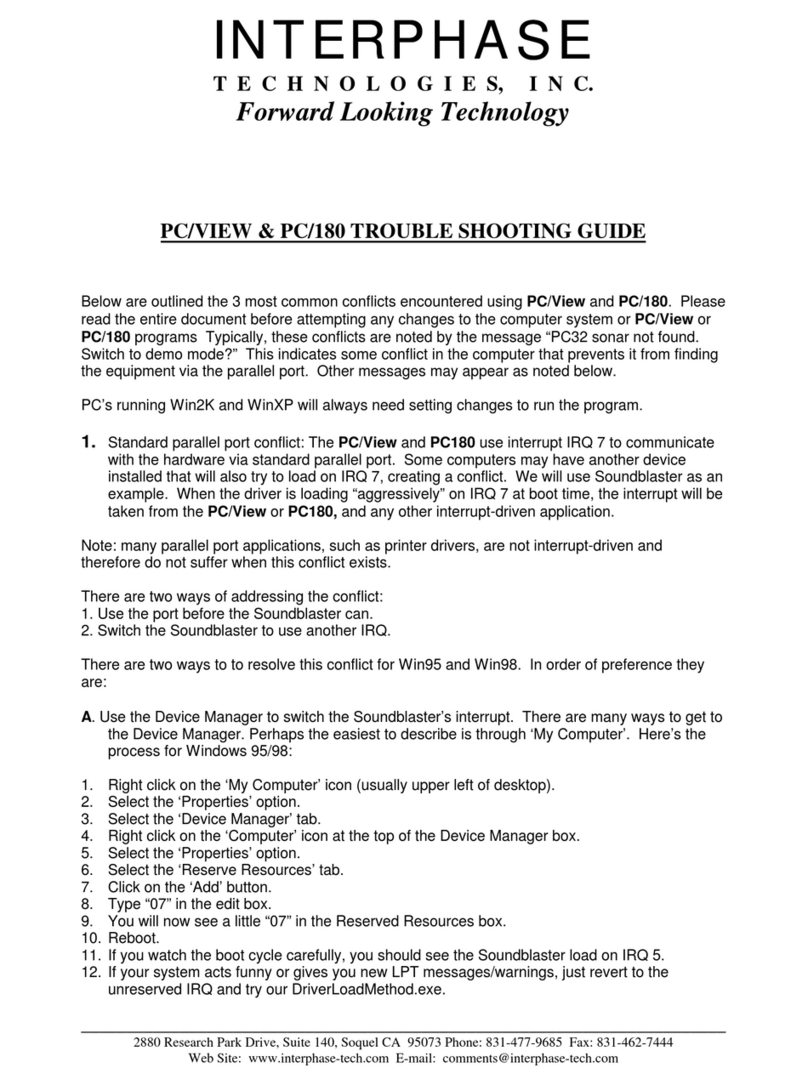
Interphase
Interphase PC/180 User manual
